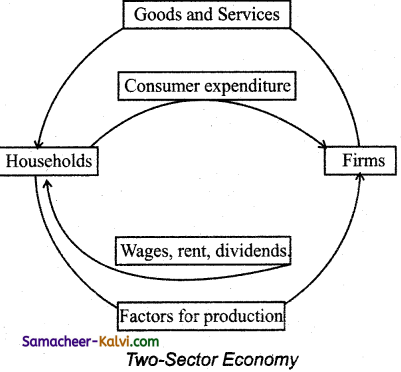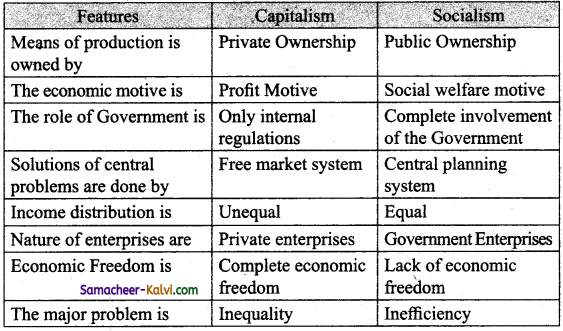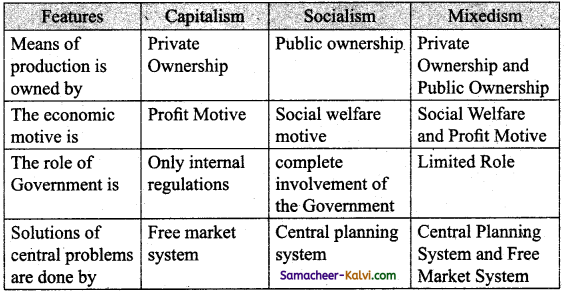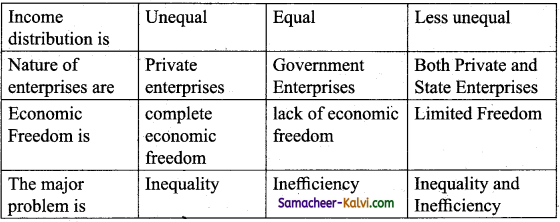TN State Board 12th Economics Important Questions Chapter 1 Introduction to Macro Economics
Question 1.
Define Macro Economics.
Answer:
It is the study of aggregates covering the entire economy such as total employment, national income, national output, total consumption, total investment, total savings, ag gregate demand and supply general price level, wage level, and cost structure.
[OR]
Macro economics is the study of the economy as a whole. It deals with aggregates such as national income, employment and output.
Question 2.
Define the term ‘Inflation’.
Answer:
Inflation refers to steady increase in general price level.
![]()
Question 3.
What is meant by an ‘Economy’?
Answer:
Definition by AJ.Brown- “A system by which people earn their living”
“An economy is a cooperation of producers and workers to make goods and services that satisfy the wants of the consumers”. – J.R.Hicks
Question 4.
Classify the economies based on status of development.
Answer:
Economies can be classified into different types based on the status of development as developed, under developed, undeveloped and developing economies. .
Question 5.
What do you mean by Capitalism?
Answer:
Capitalism- It means there is total freedom and private ownership of means of production.
![]()
Question 6.
Define ‘Economic Model’.
Answer:
A model is an explanation of how the economy, or part of the economy, works.
Question 7.
‘Circular Flow of Income’ – Define.
Answer:
It is a model of an economy showing connections between different sectors of an economy.
Question 8.
State the importance of Macro Economics.
Answer:
- The basic problems is an economy can be solved using suitable strategies if we understand the functioning of an economy at the aggregate level i.e., Macro economics.
- It is important to know macro economics so that to take precautionary . measures for future problems and for the needs and challenges of an economy.
- It provides opportunities to understand the reality and to use scientific investigations.
- It helps to compare and analyses the economic indicators.
- It helps us to predict about future economic crises and to form suitable policies.
![]()
Question 9.
Describe the different types of economic systems.
Answer:
It is the methodology of doing economic activities to meet the needs of the society. The three economic systems are:
(i) Capitalist economy:
Total freedom and private ownership of means of production.
(ii) Socialist economy:
There is public ownership means of production.
(iii) Mixed economy:
Co-existence of capitalism and socialism.
Question 10.
Outline the major merits of capitalism.
Answer:
- Automatic working: The economic works automatically without any interventions of government.
- Efficient use of resources: Resources are used to its maximum.
- Incentives for hard work: The entrepreneurs earn maximum profit for their efficiency.
- Economic progress: Productivity level is maximum.
- Consumer’s sovereignty: Production aims to give maximum satisfaction to the consumers.
- Higher rate of capital formation: Because of increase in savings and investment.
- Development of new technologies: The producers invest on new technologies to produce quality products and to maximise profit.
![]()
Question 11.
Indicate the demerits of socialism.
Answer:
Demerits of socialism:
(i) Red tapism and bureaucracy:
The decisions are taken by the government, there are chances of corruptions and delay.
(ii) Absence of incentive:
In socialism, efficiency is not encouraged so there is reduction in production also.
(iii) Limited freedom of choice:
Consumers choices are limited on goods and services.
(iv) Concentration of Power:
Major decisions are taken only by the Government so, in many cases, the power can be misused.
Question 12.
Enumerate the features of mixed economy.
Answer:
Ownership of property and means of production:
Because of the co¬existence of public and private sectors, production, properties are owned by both and they have the right to use and transfer resources.
Co-existence of public and private sectors:
Private industries are for profit and public sector work for social welfare.
Economic planning:
Economic and national planning is done in common by central planning authority of the Government and it is abided by all sectors.
Solution to economic problems:
The basic economic problems are solved through price mechanism and Government intervention.
Freedom and control:
The overall control on the economic activities are with the government.
![]()
Question 13.
Distinguish between Capitalism and Globalism.
Answer:
|
Capitalism |
Globalism |
| In capitalism the role of the government is minimum and the market determines the economic activities. | In globalism, the new market ideology of globalization connects nations together through international trade and aiming at global development. |
| Capitalist economy is also known as market economy. | Globalism is also termed as extended capitalism. |
Question 14.
Briefly explain the two sector circular flow model.
Answer:
The circular flow of income is a model of an economy showing connections between different sectors of an economy. There are two sectors i.e., household and firms.
(i) The household sector receives income from firm sector by providing the factors of productions owned by it.
(ii) The firm gets its income by selling goods and services to the household sector. It sells the entire output of households. In the two sector economy, production and sales are equal.
Diagram of two sector economy

(i) Outer circle – Real flow [factors and goods]
(ii) Inner circle – Monetary flow[factor and commodity prices]
Y = C + 1 → basic identity
Y = income, C = Consumption, I = Investment
(a) Factor services flow from household to firm and
(b) Goods and services flow from firm to household
![]()
Question 15.
Discuss the scope of Macro Economics.
Answer:
Macro economic study has a wide scope and it covers major areas of economics such as:
(i) National income:
The growth process of an economy depends on the composition and measurement of its national income.
(ii) Inflation:
The general price level is estimated by constructing various price index numbers such as whole sale price index, consumer price index. This is given by macro economics.
(iii) Business cycle:
The cyclical movements such as boom, recession, depression and recovery in the economy are studied as business fluctuations under macro economics.
(iv) Poverty and unemployment:
It is the most important economic paradoxes of rich nations. Macro economic studies gives a clear understanding about the magnitude of poverty and unemployment and the corrective measures.
(v) Economic growth:
Macro economic analysis study helps to understand the growth and development of an economy.
(vi) Economic policies:
The basic problems of an economy are solved by economic policies. Economic policies are framed through macro economic studies. These are the scope of macro economic studies.
Question 16.
Illustrate the functioning of an economy based on its activities.
Answer:
Economy is a system where the Economic activities are carried out. The economic functions and activities varies according to the character of each economy. [Refer to flowchart given in III (B) -1]
Explanation:
The fundamental economic activities of an economy are
- Production and
- Consumption.
The aim of the activities are to achieve growth. The production and consumption activities are known as fundamental economic activities. They are supported by exchange activity Economic and Non – Economic activities.
The economic activities are:
Transportation, banking, advertising, planning and Government Policies.
The Non-Economic activities are:
Environment, Education, Entertainment, Government regulations etc.
The Supporting activities or External activities are:
Import, Export, international relations, Emigration, Immigration, Foreign investment, Foreign exchange earnings etc., These activities also influence the entire functioning of the economy.
![]()
Question 17.
Compare the features of capitalism and socialism.
Answer:

Question 18.
Compare the feature among Capitalism, Socialism and Mixedism.
Answer:


![]()
Multiple Choice Questions:
Question 1.
The branches of the subject Economics is:
(a) Wealth and welfare
(b) Production and consumption
(c) Demand and supply
(d) Micro and macro
Answer:
(d) Micro and macro
Question 2.
Who coined the word ‘Macro’?
(a) Adam Smith
(b) J M Keynes
(c) Ragnar Frisch
(d) Karl Marx
Answer:
(c) Ragnar Frisch
Question 3.
Who is regarded as Father of Modern Macro Economics?
(a) Adam Smith
(b) J M Keynes
(c) Ragnar Frisch
(d) Karl Marx
Answer:
(b) J M Keynes
![]()
Question 4.
Identify the other name for Macro Economics:
(a) Price Theory
(b) Income Theory
(c) Market Theory
(d) Micro Theory
Answer:
(b) Income Theory
Question 5.
Macro economics is a study of:
(a) individuals
(b) firms
(c) a nation
(d) aggregates
Answer:
(d) aggregates
Question 6.
Indicate the contribution of J M Keynes to economics.
(a) Wealth of Nations
(b) General Theory
(c) Capital
(d) Public Finance
Answer:
(b) General Theory
![]()
Question 7.
A steady increase in general price level is termed as:
(a) Wholesale price index
(b) Business Cycle
(c) Inflation
(d) National Income
Answer:
(c) Inflation
Question 8.
Identify the necessity of Economic policies.
(a) to solve the basic problems
(b) to overcome the obstacles
(c) to achieve growth
(d) all the above
Answer:
(d) all the above
Question 9.
Indicate the fundamental economic activities of an economy.
(a) Production and Distribution
(b) Production and Exchange
(c) Production and Consumption
(d) Production and Marketing
Answer:
(c) Production and Consumption
![]()
Question 10.
An economy consists of:
(a) Consumption sector
(b) Production Sector
(c) Government sector
(d) All of the above
Answer:
(d) All of the above
Question 11.
Identify the economic system where only private ownership of production exists.
(a) Capitalistic Economy
(b) Socialistic Economy
(c) Globalistic Economy
(d) Mixed Economy
Answer:
(a) Capitalistic Economy
Question 12.
Economic system representing equality in distribution is:
(a) Capitalism
(b) Globalism
(c) Mixedism
(d) Socialism
Answer:
(d) Socialism
![]()
Question 13.
Who is referred as ‘Father of Capitalism’?
(a) Adam Smith
(b) Karl Marx
(c) Thackeray
(d) J M Keynes
Answer:
(a) Adam Smith
Question 14.
The country following Capitalism is:
(a) Russia
(b) America
(c) India
(d) China
Answer:
(b) America
Question 15.
Identify The Father of Socialism.
(a) J M Keynes
(b) Karl Marx
(c) Adam Smith
(d) Samuelson
Answer:
(b) Karl Marx
![]()
Question 16.
An economic system where the economic activities of a nation are done both by the private and public together is termed as:
(a) Capitalistic Economy
(b) Socialistic Economy
(c) Globalistic Economy
(d) Mixed Economy
Answer:
(d) Mixed Economy
Question 17.
Quantity of a commodity accumulated at a point of time is termed as:
(a) production
(b) stock
(c) variable
(d) flow
Answer:
(b) stock
Question 18.
Identify the flow variable:
(a) money supply
(b) assets
(c) income
(d) foreign exchange reserves
Answer:
(c) income
![]()
Question 19.
Identify the sectors of a Two Sector Model:
(a) Households and Firms
(b) Private and Public
(c) Internal and External
(d) Firms and Government
Answer:
(a) Households and Firms
Question 20.
The Circular Flow Model that represents an open Economy:
(a) Two Sector Model
(b) Three Sector Model
(c) Four Sector Model
(d) All the above
Answer:
(c) Four Sector Model
Samacheer Kalvi 12th Economics Notes Chapter 1 Introduction to Macro Economics
→ National Income: Total Income of residents of a Country.
→ Inflation: A sustained rise in general Price level
→ Business Level: The recurring and fluctuating level of Economic Activity.
→ Balance of Payment: A statement of Countries Economic Transaction with the rest of the world.
→ Foreign Exchange Reserves: Assets held by Central bank (RBI) and monetary authorities usually in different reserve currencies.
→ Laissez Faire: A policy of complete Non-Intervention by Government in the Economy leaving all decisions to the market.
→ Exchange Rate: The price (rate) at which one currency is exchanged for another.
→ Economic Growth: Economic growth is a process of sustained increase in Country’s real income over a long period of time.
→ Balance of Trade: It is the difference between the money value of Exports and Imports of material goods.
→ External Sector: It refers to the Economic transaction of the domestic country with the rest of the world.